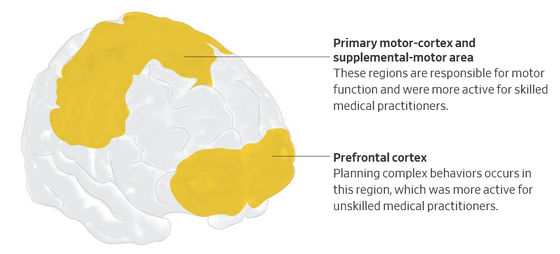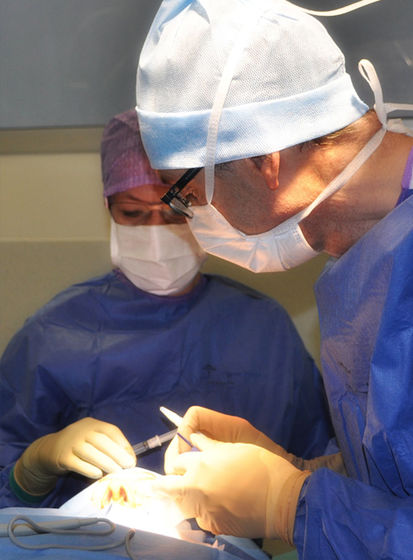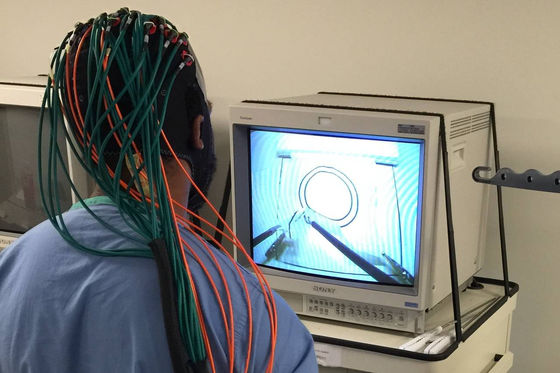A technique is developed to monitor brain activity and discriminate 'whether you have skilled skills or not'

In the field requiring highly skilled skills such as surgical operations, it is necessary to measure "how much skill this person has" when evaluating a specific person. A researcher developed a technique to discriminate the evaluation of the skill that relied on subjective evaluation by optical brain activity monitoring in the past.
Assessing bimanual motor skills with optical neuroimaging | Science Advances
http://advances.sciencemag.org/content/4/10/eaat3807
Brain Scans Can Detect Who Has Better Skills - WSJ
https://www.wsj.com/articles/brain-scans-can-detect-who-has-better-skills-1538589600
Researchers are trying to observe the situation in the brain using brain scan technology and to gain new insights on skill evaluation to identify people with special skills. The collaborative research team of Rensselaer Polytechnic Institute and Harvard Medical School discriminates "beginner surgeon" and "skilled surgeon" by doing a brain scan while a surgeon is conducting a surgical simulation and analyzing data We developed a method.
The part of the brain that is useful for measuring the skill is the premotor cortex related to the primary motor cortex that controls the planning and execution of exercise , the supplementary motor cortex , and the plan of complex cognitive behavior etc. According to the research team, the activity in the brain during the surgical simulation is active in the primary motor cortex and the supplementary motor cortex for skilled surgeons, while the beginner surgeon will actively activate the prefrontal cortex .

In the study, we scanned and monitored the brains of 30 skilled physicians and researchers during the surgical simulation, which is the task of certifying surgeon skills. The research team says that "skill judgment by brain monitoring is the stage of early testing," while evaluating the surgical skill based on the data analyzing the brain is more accurate than the conventional subjective skill evaluation.
The skill evaluation method based on the brain scan developed this time is a first step towards system development to evaluate the level of professional skill by analyzing neurological data. The use of brain data may be realized in the future in the development of professionals such as physicians, aircraft pilots and athletes related to hand movement and eye movements.
By identifying surgeon proficiency with objective data, it is possible to make the surgeon training system even more efficient. The research team further tested the evaluation system with practical settings, and said that he would like to improve so that special skills other than skills related to hand motion can be evaluated. While practical application of the new system will greatly contribute to the evaluation of professional skills, some neurologists are worried that they will be forced to do a brain scan during skill assessment.

by Docteur Spitalier Philippe
With the development of technology in recent years, the device that scans human brain activity has been miniaturized, and the state of the brain can be scanned even if it is not sit still in front of a huge monitor. By doing this, researchers can investigate how brains are active in their daily activities and movements.
The research team wearing a cap that irradiates near-infrared light to the skull called a near infrared brain function measurement method (fNIRS) which is a safe and simple brain activity measurement method, and uses brain activity Was measured. In fNIRS, it can be seen that the oxygen that is abundantly delivered is activated, because it can be seen whether the blood flowing to the relevant part contains oxygen rich or not by the light detected by the cap.
In recent years, optical brain scanning technology seems to be progressing greatly, as a large amount of funds were dropped by Silicon Valley investors who are fascinated with brain interfaces. Ethical problems are involved in acquiring brain data, but even more research is needed to prevent discrimination based on low-reliability data.

Related Posts:
in Science, Posted by log1h_ik







